Table of contents
- PS technology series part 15 Bearing points on the frame
- Steering head bearings
- Steering damper
- Fork legs
- Wheel bearings
- Strut eyes
- Swing arm bearing
- Reversing lever
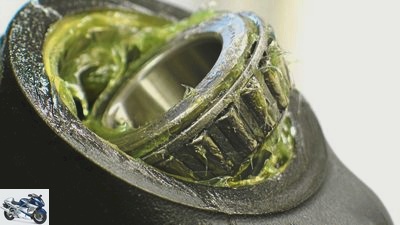
Cook
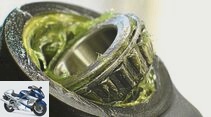
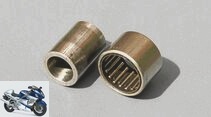
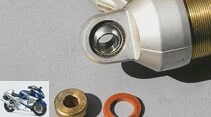
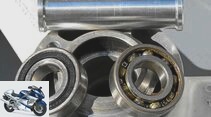
10 pictures
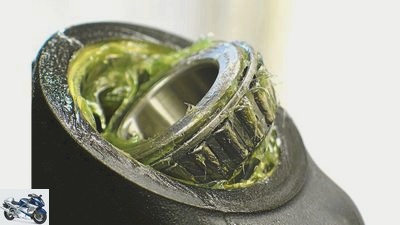
Cook
1/10
If you doubt your driving ability because every curve radius becomes a hexagon and the motorcycle no longer meets a line, a thorough check of the steering head bearings is advisable.
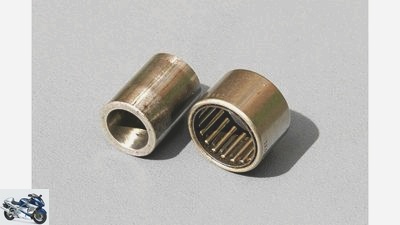
Cook
2/10
Swing arm bearings: So-called needle sleeves with a thin outer ring are pressed into the swing arm and supplemented by an inner ring.
Manufacturing tolerances are programmed.
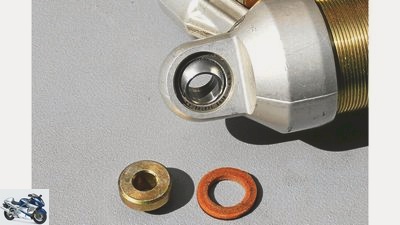
Cook
3/10
Suspension strut eyes: Ball joints (photo), needle bearings or rubber bearings ensure that the pivoting movements on the shock absorber do not build up any destructive side forces.
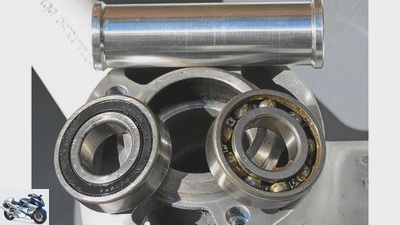
Cook
4/10
Wheel bearings: Deep groove ball bearings with a seal facing outwards and the spacer tube between the inner rings are shrunk into the wheel hub. Damage usually only occurs when water penetrates.
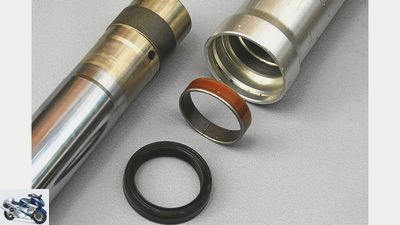
Cook
5/10
Fork legs: between the immersion tube and the standpipe, slide bearings (arrow), which are lubricated by the fork oil, ensure that the spring moves with as little friction as possible. The hydraulic system is sealed by a Simmerring.
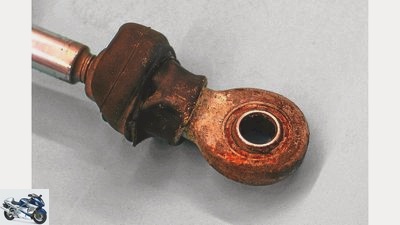
Cook
6/10
Steering damper: The ball joint bearings on both sides must work smoothly and without play. Which is not the case with this spherical bearing corroded under the rubber cap.
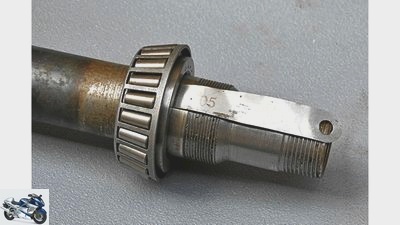
Cook
7/10
Too much play between the steering tube and the bearing inner ring can cause problems.
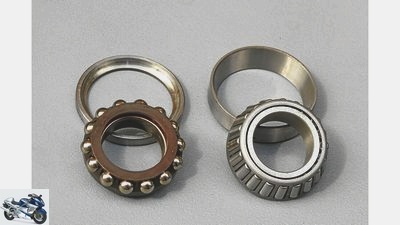
Cook
8/10
Steering head bearings: Adjustable shoulder ball bearings (left) or tapered roller bearings guide the steering tube in the frame.
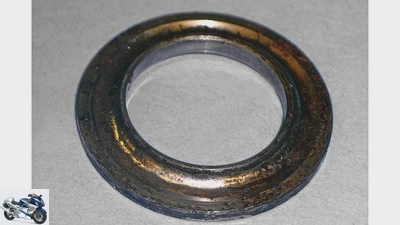
Cook
9/10
If you doubt your driving ability because every curve radius becomes a hexagon and the motorcycle no longer meets a line, a thorough check of the steering head bearings is advisable. If the bearing shells are pressed in by the rolling elements, in the photo a shoulder ball bearing, the steering is hooked. The motorcycle can then no longer swing and wobbles uncertainly around the bends in an inclined position. This treacherous damage slowly creeps in and is often not recognized.
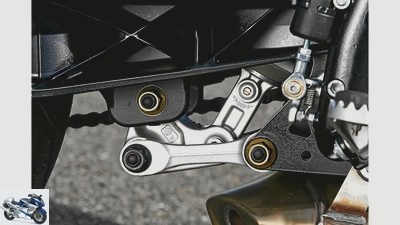
Cook
10/10
Deflection lever: Here too, needle sleeves are usually installed which, due to the manufacturing tolerances, often cause excessive radial play.
counselor
technology & future
Bearing points on the frame
PS technology series part 15
Bearing points on the frame
Content of
Fat forks, bomb-proof frames and monstrous swing arms keep the wheels safely on track. The little problem with it: the rotatable and swiveling connections that cause some stable constructions to sway.
Werner Koch
06/17/2014
Viewed in slow motion, all frame components change their position when the motorcycle takes a rapid cornering. The fork, steering system and rear wheel suspension often only adjust to a few millimeters or angular minutes, depending on the inclination or bumps in the road. If these barely noticeable rotational movements are hindered by stiff bearings, the entire system becomes unbalanced, the motorcycle becomes unstable and no longer cushions bumps. So all moving components have to respond sensitively and without breakout force, even under high loads. On the other hand, the bearing points must be able to withstand the high forces with absolutely no play. This balancing act is best achieved with so-called roller bearings.
Buy complete article
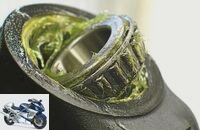
PS technology series part 15
Bearing points on the frame
4 pages) as PDF
€ 2.00
Buy now
The rolling elements rotate between the two bearing shells with little resistance, even at high pressures and forces. The most common forms of motorcycle frames: needle, tapered roller and ball bearings. So-called slide bearings with Teflon-coated surfaces are installed between the fork dip and standpipe, which are permanently lubricated by the fork oil. Even if the bearing quality has improved significantly in large-scale production, longer running times can lead to increased bearing play or defects, for which the bearing guru Emil Schwarz (www.emilschwarz.de) is still a good address.
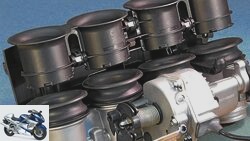
workshop
PS technology special
Further training for motorcyclists
read more
Steering head bearings
The bearing shells pressed into the frame are among the most heavily stressed components, as the entire vehicle mass is supported on the long lever arm consisting of the wheel radius and fork bars when the brakes are applied hard. At the same time, these bearings must allow even the smallest steering movements to run smoothly without friction. For a long time, tapered roller bearings were considered the non plus ultra due to their high load capacity and thus long service life. However, these bearings require an absolutely round bearing seat, which was not always guaranteed (welding distortion during manufacture). The setting must also be made meticulously. Adjusted a touch too tight, the friction increases significantly, the motorcycle tilts and steers imprecisely.
This is precisely why the smooth shoulder bearings are becoming more and more popular. The only punctual contact surface of the balls reduces friction, and these bearings also react less sensitively to non-round bearing seats. In general, when setting the bearing play, regardless of whether it is a ball or tapered roller bearing, the following applies: as smoothly as possible, only as tightly as necessary. For precise adjustment, the steering damper must be detached and the clamping screws of the upper triple clamps loosened. The locknuts and central nut on the steering tube must be tightened, as this force has a massive impact on the bearing play.
Steering damper
This hydraulic safeguard against handlebar slap is usually suspended in two ball joints. Like the steering head bearing, these are moved even with the smallest changes in angle. Therefore, the ball heads must be absolutely smooth. Occasionally a drop of silicone oil will not do any harm and will prevent corrosion.
The damper must not be clamped, as the side forces that occur increase the friction on the piston rod. The damping force must be constant and must not work irregularly due to air bubbles in the system. For this test, remove the damper and move it back and forth several times. In general, the following applies to the steering damper: as little damping force as possible and as much as necessary to slow down kickback.
Fork legs
When it comes to the slide bearings in the fork, the manufacturers have to find a good compromise between ease of movement and low running clearance. Generous running play reduces friction, especially the so-called slipstick effect (breakaway force). This increased friction is a result of the manufacturing tolerances of fork bridges, dip tubes and axle bores, which can only be compensated for by a running clearance of around 0.10 to 0.15 millimeters. There is no provision for setting the bearing play, but specialized companies with oversize bearings and surface treatment can reduce play and friction.
Signs of worn bearings or leaking immersion tubes (only with conventional forks) are leaky Simmerrings, which, due to the high radial play, cannot hold back the fork oil that is under pressure during compression. To check, first relieve the front of the motorcycle, then the fork legs must be moved back and forth forcefully in the longitudinal direction. If there is noticeable play on the axle, the fork must be dismantled and measured.
Wheel bearings
With a few exceptions (needle roller bearings on some Yamaha R1 models and tapered roller bearings on old BMWs), the wheels turn on sealed deep groove ball bearings that are shrunk into the bearing seats of the hub. A spacer tube sits in between, which is supported on the two bearing inner rings and thus allows the wheel axle to be tightened. When removing and installing the bearings, the hub must be heated to around 80 degrees with a hot air blower, hot plate or gas burner. If the bearings are driven in and out cold, the seat can be irreparably damaged.
Completely relieved, the wheel is tilted horizontally and vertically with both hands at right angles to the direction of travel. Excessive play or wear is rare in modern motorcycles. Corrosion damage caused by water penetrating through the Simmerrings during steam jetting is the cause of a defect in the wheel bearing.
Strut eyes
Regardless of whether it is two struts or a central strut with or without deflection, the ends of all variants must be rotatable. With conventional stereo struts, an elastic rubber mount is sufficient to compensate for the very small angle of rotation. It is different with the monoshock, which is firstly exposed to an extremely high load and where the angle of rotation is very large depending on the deflection system. Sealed ball joints or needle bearings work here, which guarantee that the piston rod is spared from lateral forces. However, this is only possible if the ball joint bearings are well lubricated and have sufficient freedom of movement in all directions. The freedom of movement of the ball joints or needle bearings can only be checked when they are removed; possible play is checked together with the reversing levers.
Swing arm bearing
With a few exceptions (cardan swing arms), the rear wheel swing arms rotate in so-called needle sleeves. In contrast to needle roller bearings, these have a relatively thin outer ring made of hardened sheet steel. This needle sleeve is pressed into the bearing seat and receives its final internal dimensions. Due to the manufacturing tolerances of the bore, the bearing play is often too large, which can be compensated for by specially manufactured inner bearings.
Too much bearing play can also result from the swing arm warming up (waste heat from the engine) and the widened bearing seat caused by thermal expansion. Lateral play on the swing arm (axial play), however, is completely harmless up to a value of one millimeter.
Reversing lever
Due to the large mechanical transmission, the forces on the needle sleeves of the deflection systems also increase. If too much radial play builds up there, this can triple on the rear axle. To check, the relieved rocker is vigorously moved up and down. Where exactly the game occurs can be determined by a visual inspection by a second person. This height play on the rear axle can also trigger chattering, i.e. vibrations in the chassis, on super sports motorcycles.
Related articles
-
counselor workshop Change the wheel bearing Change the wheel bearing on the motorcycle With a mandrel, hot air and bearing grease Changing wheel bearings…
-
Kawasaki 15th pictures archive 1/15 The frame is crucial for the driving behavior. archive 2/15 When designing the main frame, the following parameters,…
-
Adviser: change the steering head bearing
Schermer counselor workshop Adviser: change the steering head bearing Adviser: change the steering head bearing Check and replace steering head bearings…
-
Change the steering head bearing
counselor workshop Change the steering head bearing Change the steering head bearing Change the steering head bearing If the bearing in the steering head…
-
archive counselor technology & future Technology frame types Technology explained Everything about frame types Full braking, marginal lean or full shower…
-
Adviser: change the wheel bearing
Schermer 7th pictures Schermer 1/7 Changing the wheel bearing Step 7: When driving in, carefully tap into the outer ring with a mandrel.. Schermer 2/7…
-
Advisor This is how the steering head bearing stays fit
counselor workshop Advisor This is how the steering head bearing stays fit So the steering head bearing stays fit Screwdriver tip part 2 The second part…
-
Indian Challenger Recall: Transmission Output Bearing Issues
Indian, Barry Hathaway 14th pictures Indian 1/14 Indian is launching a completely new series with the Challenger. Indian 2/14 The excavator-style model…
-
BMW Motorrad: New aluminum frame with carbon reinforcements
BMW. 4th pictures BMW motorcycle 1/4 BMW Motorrad would like to add stiffening elements made of composite materials to a standard aluminum frame. The…
-
Advice: check and adjust steering head bearings
Cook 9 pictures Cook 1/9 Checking and adjusting the steering head bearing – Step 2: Loosen the central nut on the steering shaft. Only use a nut and a…